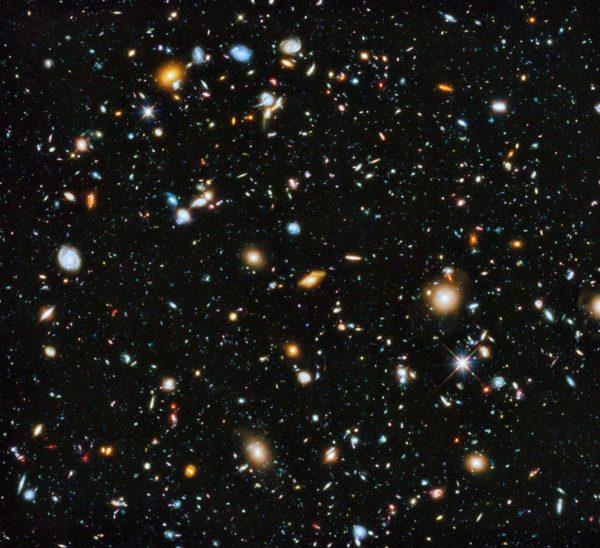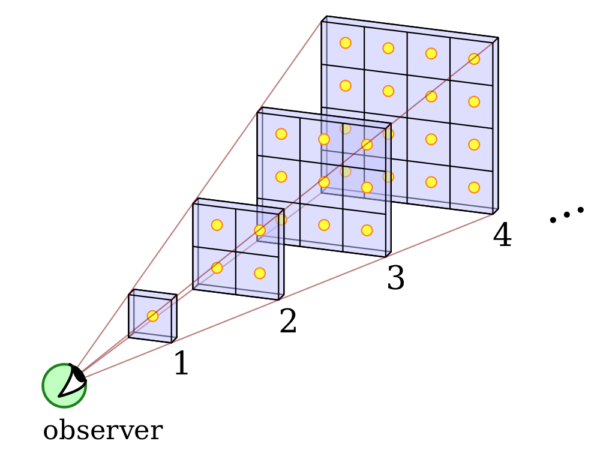"When you get just a complete sense of blackness or void ahead of you, that somehow the future looks an impossible place to be, and the direction you are going seems to have no purpose, there is this word despair which is a very awful thing to feel." -Stephen Fry
Perhaps the most fundamental difference between day and night is the difference between light and dark that our eyes perceive. While everything is illuminated during the day, the night sky is completely dark, with the sole exception of the stars, galaxies and objects reflecting sunlight back at our world.
 The full UV-visible-IR composite of the XDF; the greatest image ever released of the distant Universe. Image credit: NASA, ESA, H. Teplitz and M. Rafelski (IPAC/Caltech), A. Koekemoer (STScI), R. Windhorst (Arizona State University), and Z. Levay (STScI).
The full UV-visible-IR composite of the XDF; the greatest image ever released of the distant Universe. Image credit: NASA, ESA, H. Teplitz and M. Rafelski (IPAC/Caltech), A. Koekemoer (STScI), R. Windhorst (Arizona State University), and Z. Levay (STScI).
You might intuit that this is simply because we can't gather enough light to see the most distant objects in the Universe, but even if we gather arbitrarily large amounts of light, there are still dark spaces between the galaxies, where no shining objects exist. Indeed, there's a mathematical theorem that if the Universe were of infinite size and a uniform (even if small) density, every direction you looked would eventually end on a light source.
 An illustration of “Olbers’ Paradox”, and how given a uniformly dense Universe, you’d run into an infinite amount of starlight in any direction. Image credit: Wikimedia Commons user Htkym, under a c.c.a.-s.a.-3.0 license.
An illustration of “Olbers’ Paradox”, and how given a uniformly dense Universe, you’d run into an infinite amount of starlight in any direction. Image credit: Wikimedia Commons user Htkym, under a c.c.a.-s.a.-3.0 license.
The resolution lies in two sources: the Big Bang and the limitations of our vision's wavelength perception. Go get the whole story on this week's Ask Ethan!

Thought it would be insightful..but left dissappointed. Wasted three paragraphs on common sense.
A lot of people are missing common sense, though.
See See Nowt.
A new paper (from arXiv) on just this topic: http://arxiv.org/abs/1605.08085 . The author argues that the dimness of the extragalactic background light (EBL) is due primarily to dust extinction. He claims that even in a static infinite Universe, the EBL with dust would be lower than the "raw" EBL from Olbers' Paradox.
Our sun at 93 million miles has an apparent magnitude of -26.74, but has an absolute magnitude of 4.83--for the uninitiated--it is the brightness our sun would appear to have at a distance of 10 parsecs, or roughly 32 light years, or 58.8 trillion miles away. If it were the only star in the sky on a clear night at that distance it would be just visible to the naked eye of a person with average eyesight. Galaxies generate billions or trillions of times as much light as our sun, but the distance to them is so great that even our nearest galactic siblings only appear as dull smudges in the sky. Find the smallest grain of dark colored sand that you can resolve with your eye and put it on a white sheet of paper. This will be the sun. One inch away, imagine another teensy grain of sand 1/100th the diameter of the first. This will be the earth... the one inch represents about 93,000,000 miles. On this scale, Alpha Centauri, is about 4 and a third miles away, also the size of a grain of sand. The very nearest star to us, that we're aware of, is Proxima Centauri which would be 4 and a quarter miles away. Grains of sand miles apart is a goo way to visualize the density of space. One last thought... build a bedroom with black walls and a black, thousand-foot high ceiling. Put a single 100-watt lightbulb on the ceiling to read by while you lie in bed below. When your eye is an inch from the bulb, it's blinding... but 1000 feet in the air...
The explanation is wrong. There is lots of light coming from the directions that we perceive as dark. The issue is that the light has been so far red-shifted by the expansion of the universe that it's outside our ability to perceive it.
@Dave #5: Did you actually read the article? That's exactly what the CMB is, as Ethan explained.
Suggest that you should read the article. Doppler red shift is never mentioned. The article identifies CMB as a residual glow, not as red-shifted light.
"even in a static infinite Universe, the EBL with dust would be lower than the “raw” EBL from Olbers’ Paradox."
And I say he's talking bollocks. So we have to work out WHY those claims may hold up. His and mine.
After infinite time, that dust would have heated up to an incandescent temperature. So even if it were infinite in size, it would STILL have to be finite in age. Which them begs the question how did that stuff get infinitely far apart in finite time?
"The explanation is wrong. There is lots of light coming from the directions that we perceive as dark. "
Your claim is wrong. Both of them.
The redshifting is the expansion of space during the time of travel for the light. It started out fitting X number of wavelengths in the universe and by god it's going to STAY with the same X!
This has nothing to do with removing Olber's paradox.